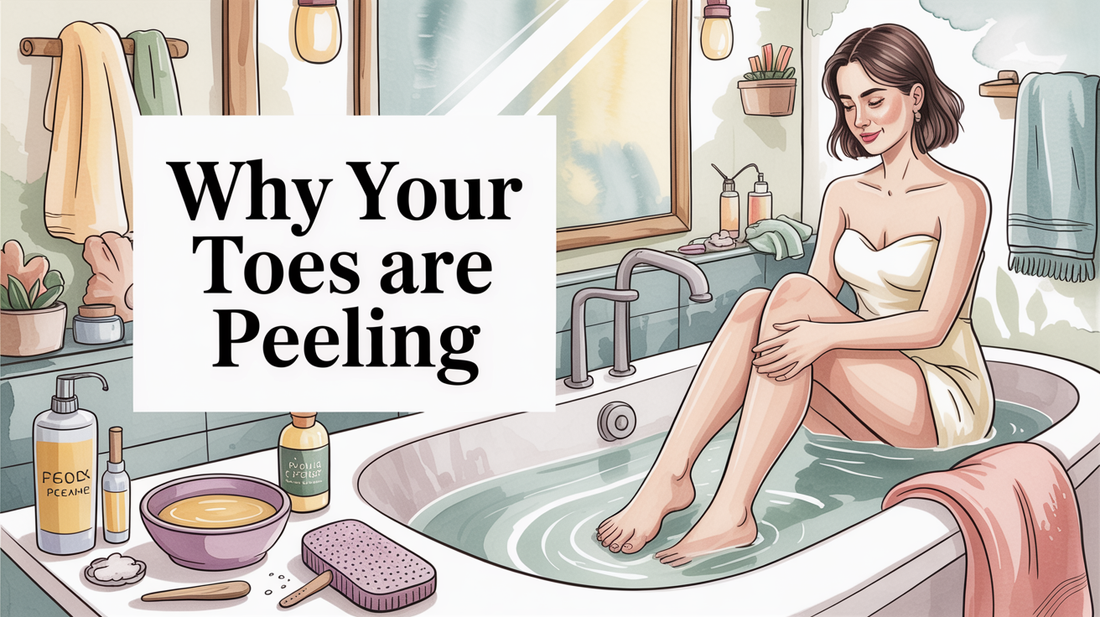Are peeling toes a sign of unhealthy feet?
peeling toes, interdigital peeling, fungal signs — If you've noticed peeling toes, you’re not alone. This issue may indicate various underlying concerns, from fungal signs to environmental factors. In this post, we'll explore common triggers, peel patterns to note, and targeted treatments that may help support your foot health. Let's get started!
Common triggers 🧭
Peeling toes can arise from a range of environmental, medical, and lifestyle factors. Identifying these triggers is essential for understanding the cause and applying appropriate care. One of the most common reasons for interdigital peeling is fungal infections, particularly athlete's foot, which often affects the spaces between the toes. Excess moisture from sweating or prolonged exposure to wet conditions can exacerbate this issue.
Other contributors may include dry skin from lack of hydration, contact dermatitis caused by soaps or shoe materials, and skin conditions such as eczema or psoriasis. Bacterial infections can also thrive in warm, moist environments, leading to additional complications. Furthermore, overusing harsh scrubs or chemical peels can cause irritation and peeling.
- Fungal infections (athlete's foot) — a common source, especially between toes.
- Excessive moisture from sweating or wet conditions.
- Dry skin and inadequate moisturizing practices.
- Contact dermatitis from soaps and shoe materials.
- Skin conditions such as eczema or psoriasis.
- Bacterial infections in warm, moist areas.
- Overuse of harsh foot treatments.
Try It Tonight: Calm, Fresh Feet ✨
- Wash feet with warm water and a gentle cleanser; dry thoroughly between toes.
- Apply a small amount of Kissable Feet where needed; massage until absorbed.
- Allow skin to breathe; wear breathable socks if preferred. Patch-test first if new to this foot cream.
Peel patterns to note ✨
Recognizing different peeling patterns can help you understand potential underlying conditions. For example, white, soggy peeling between the toes typically indicates a fungal infection like athlete's foot. In contrast, circular or ring-shaped peeling patches may suggest that the fungal infection is spreading outward.
Symmetrical peeling on both feet can point to systemic skin conditions, such as eczema, while peeling with red, inflamed borders may indicate a secondary bacterial infection. Seasonal patterns of peeling might suggest environmental triggers or contact allergies, which can be particularly relevant during certain times of the year.
- White, soggy peeling between toes — often a sign of athlete's foot.
- Circular peeling patches — may indicate spreading fungal infection.
- Symmetrical peeling on both feet — points to systemic conditions like eczema.
- Peeling with red borders — could signify bacterial infection.
- Seasonal peeling patterns — suggest environmental allergies.
Why We Recommend a Gentle Helper 🌿
Kissable Feet is specially crafted for quick absorption and a soothing, non-sting feel. This blend of tea tree, coconut, and calendula is designed to provide comfort while ensuring a clean finish—making it an easy addition to your nightly routine.
- Fast-absorbing comfort with a non-greasy finish.
- Gentle sensation suitable for sensitive, overworked feet.
- Clean, calming scent perfect for bedtime.
Targeted treatments 🔍
Treatment methods for toe peeling vary based on the underlying cause. Proper diagnosis is essential for selecting the most effective method while also preventing recurrence. For confirmed fungal infections, antifungal creams or powders may help. Gentle moisturizing with urea or lactic acid-based creams can support dry skin.
For bacterial infections, topical antibiotics may be necessary, while inflammatory conditions like eczema could benefit from steroid creams under medical supervision. Preventive measures, such as maintaining proper foot hygiene, wearing breathable footwear, and controlling moisture, are crucial for long-term health.
- Antifungal creams or powders for fungal infections.
- Moisturizers with urea or lactic acid for dry skin.
- Topical antibiotics for bacterial infections.
- Steroid creams for inflammatory conditions (with medical guidance).
- Preventive steps: proper hygiene and breathable footwear.

